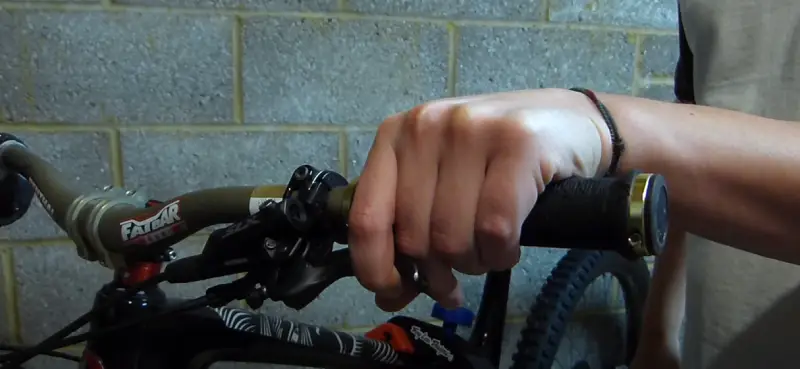Bicycle touring can cause wrist pain if your posture does not seem correct. Cycling can lead to various wrist injuries, including fractures, sprains, tendinitis, carpal tunnel syndrome, cyclist’s palsy, De Quervain’s tenosynovitis, and scaphoid fracture.
Ensuring proper bike fit, warm-up stretching, using wrist guards, taking regular breaks, and applying ice or heat therapy is crucial for cycling with a wrist injury. If you experience persistent wrist pain, seeking medical attention is highly recommended.
This blog post discusses wrist injuries, factors to consider, and recommended cycling techniques for cycling with wrist injuries. With this guide, you can still enjoy cycling even if you have a wrist injury, no matter your level.
How To Cycle With Wrist Injury: 5 Essential Riding Tweaks

A wrist injury can significantly impact your cycling ability, but the good news is that there are ways to continue cycling without aggravating the injury.
Upright Riding Position
Maintaining an upright riding position can relieve the pressure on your wrists and prevent further injuries. Here are some tips for achieving an upright riding position:
- Adjust your handlebars and saddle to be at a comfortable height.
- Keep your elbows slightly bent and close to your body.
- Avoid leaning too far forward or backward.
- Use your core muscles to maintain a steady position on the bike.
Avoiding Bumps and Jumps
Bumps and jumps can be painful for those with a wrist injury, so taking precautions is essential to avoid them. The following tips will help you:
- Choose smooth terrain for your rides.
- Approach obstacles such as speed bumps and jumps cautiously and slowly.
- Keep your weight balanced on the bike to minimize the impact.
- Shift your center of gravity backward when going over obstacles.
- Bikes with suspension, whether on the front or rear, can help absorb shocks from bumps and jumps. This can help alleviate the impact on the wrist.
Avoiding Too Much Pressure
One of the significant challenges of cycling while injured is avoiding excessive pressure. Here are some tips for reducing stress:
- Use padded gloves to cushion your hands.
- Avoid gripping the handlebars too tight.
- Use your body weight to support your upper body instead of relying solely on your wrists.
- Take frequent breaks to relieve pressure.
Avoiding Prolonged Riding
It’s best to avoid prolonged riding when you have a wrist injury, as it can exacerbate the pain and prolong the healing process. Here are some tips for preventing lengthy rides:
- Start with brief passages and accumulate the distance.
- Keep your hands and wrists flexible by taking frequent breaks.
- Use a wrist brace or support if necessary.
- Whenever you feel discomfort or pain, stop and listen to your body.
5 Factors to Consider for Cycling With Wrist Injury
You may wonder if cycling is safe if you recently experienced a wrist injury. Before you hop on your bike, you need to consider several factors. Here are some essential things to keep in mind:
Severity Of The Injury
One of the first things you should consider is how severe the injury is. You can cycle without issue if you have a minor sprain. If you have more severe damage, such as a fracture, you may need to avoid cycling altogether until it has properly healed.
Doctor’s Approval
Similarly, getting your doctor’s approval before cycling with a wrist injury is essential. Your doctor can evaluate injuries, and it can be determined if it is safe for you to bike. They may offer advice on modifying your cycling routine to accommodate your injury.
Type of Injury
The type of injury you have sustained can also impact your ability to cycle. For example, if you have a wrist sprain, you may cycle if you avoid putting too much pressure on the affected wrist. If you have a wrist fracture, taking a break from cycling may be necessary until it has fully healed.
Pain Level
Another crucial consideration is your pain level. If your wrist hurts too much, you may need to take a break from cycling altogether. If your pain is manageable, you can cycle as long as you are careful and take steps to prevent further injury.
Range of Motion
You should also consider your range of motion. If your injury has limited your wrist’s mobility, you may need to adjust your cycling routine to accommodate this. For example, you may need to avoid specific handlebars or positions that put too much pressure on your wrist.
3 Pre-Cycling Preparation Tips for Cycling With Wrist Injury
![Cycling With a Wrist Injury: 3 Pre-Cycling Tips [Warm-Up Stretching]](https://cacyclinghub.com/wp-content/uploads/2024/07/3-Pre-Cycling-Preparation-Tips-for-Cycling-With-Wrist-Injury-1.webp)
Cyclists may face particular challenges, especially with wrist injuries. Whether you’ve experienced a previous injury or are looking to prevent one, taking precautions to keep your wrists safe while cycling is essential. Here are a few pre-cycling preparations you can follow:
Warm-Up Stretching
Before starting any exercise, preparing your body for the activity is essential to prevent injuries. Stretching and warming your wrists with simple exercises improves flexibility and prevents damage. These exercises may include:
- Forearm stretch: Extend one arm before you with your palm facing down. With your other hand, nuzzle your hand towards your forearm and hold for 10-15 seconds. Repeat on the other side.
- Wrists circles: Rotate your wrists in clockwise and anticlockwise circles to warm up your wrists.
- Wrist flexor stretch: Extend your arm straight out in front of you, palm facing down, and gently bend your wrist with your other hand.
- Extensor stretch: Straighten your arm with your palm up and use your other hand to bend your hand backward gently.
Use of Supporting Gear
Supporting gear such as wrist wraps and gloves can help reduce cycling injury risks. A good wrist support and protection set can make all the difference for wrist support and protection. You may invest in:
- Wrist wraps: These provide additional support to your wrists and help reduce the handlebars’ impact on your wrists.
- Cycling gloves: These gloves can help to absorb shock and provide additional cushioning to your hands and wrists during cycling.
Proper Bike Fit
Bike fit is essential for preventing injury. Poor bike fit can strain your wrists, leading to pain and potential injury. To ensure your bike is fitted correctly, consider:
- Handlebar height: Your handlebars should be level with or slightly above your saddle. This will help reduce the amount of weight and pressure on your wrists.
- Grip width: Your grip should be slightly wider than your shoulders. This will ensure that you have enough leverage and support while cycling.
- Saddle position: The saddle should be positioned so that your knees are directly over your pedals when your pedals are at the 3 o’clock and 9 o’clock positions.
4 After-Care Tips For Cyclists With Wrist Injuries

Properly caring for your body after a wrist injury while cycling is essential to avoid further damage. Proper post-cycling care can help you prevent further injuries and speed up your recovery. Here are some critical guidelines for post-cycling care to prevent further injury:
Cooling Down
Cooling down exercises help reduce muscle soreness and prevent injuries after a rigorous cycling session. These exercises should be done after every cycling session and are essential after a wrist injury. Here are a few cooling-down exercises that can help:
- Wrist circles.
- Fingers flexion and extension.
- Arm crosses.
- Shoulder shrugs.
Rest and Recovery
Rest and recovery are an essential part of any post-cycling care routine. It’s critical for wound healing and muscle recovery. You can help yourself by following these tips:
- Wait to cycle until your wrist heals.
- Avoid lifting heavy weights.
- Get enough sleep to allow your body to recover.
Ice or Heat Therapy
Ice or heat therapy is a great way to reduce swelling and pain in the wrists. Here are a few tips that can help:
- Use ice every 2-3 hours for the first 2-3 days.
- After the first 2-3 days, switch to heat therapy.
- Apply heat for 15-20 minutes, 2-3 times daily.
Continued Therapy and Rehabilitation
Continued therapy and rehabilitation are critical for wrist injury patients. These therapies will help you regain the strength and mobility of your wrist and prevent future injuries. Here are a few options that can help:
- Strengthen your wrist muscles by performing wrist curls and reverse wrist curls to improve the strength of your wrist muscles.
- Stretch your wrist gently to improve its flexibility. Some pleasant stretches include wrist flexion and wrist extension.
Conclusion
Taking certain precautions is essential to ensure your injury doesn’t worsen. Before cycling, properly prepare your bike with the adjustments to reduce strain on your wrists. It’s also necessary to use proper cycling techniques, such as gripping the handlebars with your fingers rather than your palms.
After cycling, properly care for your wrists by icing them and avoiding any activities that cause pain. The following guidelines will help you safely enjoy the many benefits of cycling while recovering from your wrist injury. Consult a medical professional if you have any concerns.
FAQs
Can I Do Cycling With Wrist Tendonitis Problem?
When you get cycling wrist tendonitis, it’s best to rest and not ride until it’s better. If the pain subsides, you can gradually start riding again, but make sure you don’t get it again.
Maintaining a good bike fit, choosing appropriate equipment, wearing gloves, and using handlebar tape to reduce pressure on the ulnar nerve are ways to prevent wrist pain. You can also do wrist mobility exercises. You should see a doctor if the pain persists.

![The 4 Tips & 5 Factors For Cycling With Wrist Injuries [4 Pre & Post Care]](https://cacyclinghub.com/wp-content/uploads/2024/07/How-To-Cycle-With-Wrist-Injury-1.webp)
